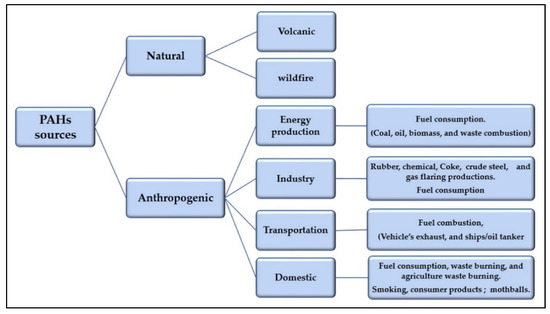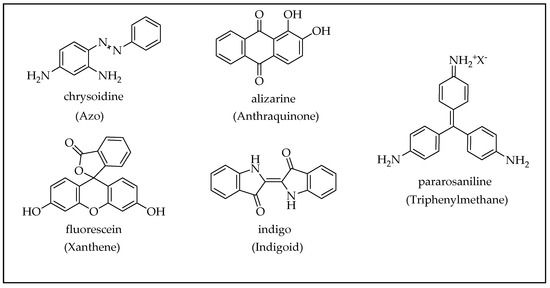In recent years, the intensification of human activities including rapid urbanization, industrialization, population, and economic growth, led to an increase in waste production and energy demand. Most importantly such activities pose concerns for health, energy security and climate changes. Hazardous volatile organic compounds, VOC, and aromatic organic compounds, AOC, are being generated from the activities of many vital industries like mining and petrochemicals. They are instrumental in the economic growth of many countries and their products are regarded as privileges to modern communities. Nevertheless, they are toxic and carcinogenic thus, these wastes have been classified as “hazardous”. The simultaneous treatment of organic pollutants and energy recovery is an attractive solution to reduce pollution in water, air, and soil as well as provide alternative clean energy sources. Hydrogen could be generated from organic pollutants in water through photocatalysis. Photocatalysis refers to the oxidation and reduction, redox, reactions on semiconductor surfaces, mediated by the valence band holes and conduction band electrons, which are generated by the absorption of ultraviolet or visible light radiation. Compared to traditional oxidation processes, photocatalytic redox reaction operates at ambient conditions without a high temperature or high pressure, and many recalcitrant organic contaminants can be degraded without the addition of chemical oxidants, hence it is fully green process. Among the various photocatalysts, TiO2, as the most widely employed “golden” photocatalyst, has been largely used in photocatalysis, due to its chemical stability, nontoxicity, and low cost. In the last two decades, TiO2 photocatalysis has expanded very quickly, having undergone various development‐related energy issues and environmental issues, such as direct solar H2O splitting into H2 and the decomposition of pollutants in air and H2O at low concentrations. Although great progress has been made in TiO2 photocatalysis, much remains unknown, which raises an interesting challenge not only for engineers but also for basic scientists. a typical photocatalytic reaction in TiO2 photocatalysis contains many fundamental processes, including charge carrier formation, separation, relaxation, trapping, transfer, recombination, and transportation.
1. Introduction
Water is essential for the existence of all living beings. However, its pollution with organic and inorganic compounds remains a threat and poses great risks to the environment and human health. The water quality is merely a concept reflecting the kind and quantity of contaminants contained in it. Mining and petrochemical industries are instrumental in the economic growth of many countries and their products are regarded as privileges to modern communities [1]. However, the wastes generated from the activities of these industries are toxic and carcinogenic [2]. Thus, these wastes have been classified as “hazardous” [3], and there is a constant increase in the pollution concerns associated with various petrochemical compounds and their by-products in the form of water, air, and soil pollution. Many of these by-products are still extensively employed, especially in the chemical, medical, and other industrial fields, as irreplaceable and inevitable raw materials [4][5][4,5,]. Aromatic compounds, such as benzene, phenol, and chlorobenzene, are some of the most encountered volatile organic compounds (VOCs). The primary sources of VOCs are originated from a large number of anthropogenic activities, such as refinery streams, especially from catalytic reforming and cracking, and petroleum refining, petrochemical processing, and solvent use [6][8,]. Other VOCs, such as methane and chlorofluorocarbons, are classified as “greenhouse gases”, which cause global warming.
The aromatic ring is the basic constituent of many organic pollutants, such as polyaromatic hydrocarbons (PAHs), dyes, pesticides, and pharmaceuticals. Aromatic compounds, such as benzene, phenols, and benzoic acid, are the most frequently used model substrates to investigate the photocatalytic mechanism and to test the activity of the photocatalysts [7][10,]. Detailed studies have been made on the harm caused by the aromatic compounds, for example, the potential relationship between the benzene-related compounds and the risk of hematologic cancers, such as lymphoid malignancies [8][14]. Moreover, long-term exposure to a low concentration of such compounds could predispose to the development of type 2 diabetes (T2D) and affect human metabolism [9][15]. Aromatic organic compounds also contribute to serious environmental problems, such as water pollution, which may result in the demise of scarce species, and biological genetic variation, which in many cases is an irreversible problem [10][17].
2. Aromatic Hydrocarbons as Water Pollutants
Many pollutants discarded into the environment contain non-degradable substances like heavy metals and organic pollutants
[11][12][29,30]. The persistent organic pollutants, such as pesticides
[13][32], aromatic organic compounds (OCs)
[14][33], semi-volatile organic compounds (SVOCs)
[15][35,], and organic dyes
[16][38] are gaining great environmental concerns due to their impacts on health and environment. These compounds have grasped much attention due to their carcinogenic potential and ubiquitous presence in the environment, which pose a major threat to water reservoirs and the surrounding ecosystem.
The aromatic organic compounds, such as benzene, toluene, ethylbenzene, and xylenes (BTEX), polyaromatic hydrocarbons (PAHs), phenols, and their derivatives are frequently detected in different wastewater resources
[17][40]. The removal of these organic pollutants is a must to reuse this water since such pollutants cannot be eliminated efficiently during conventional treatment processes. The reuse of this treated water, especially in irrigation of crops, contains great risks due to the transfer of these pollutants to plants, thus, through the food chain to living organisms
[13][32]. The following subsections provide a brief description of the main types of these pollutants.
2.1. Phenols
Phenolic compounds are a class of organic compounds that consists of a hydroxyl group(s) directly bonded to one or more aromatic rings. The phenolic compounds are classified as priority pollutants due to their carcinogenic, mutagenic properties, and high toxicity even at low concentrations
[18][41]. These compounds represent serious threats to human health, e.g., skin and eye irritations, anemia, respiratory, and vertigo
[19][42]. The Environmental Protection Agency (EPA) sets the level standard of phenols in the surface water to less than 1 µg·L
−1, while, the toxicity levels for both humans and aquatic life are usually in the range 9–25 mg·L
−1 [18][41]. Phenols are one of the main intermediates for household and industrial productions of cleaners, dyes, pesticides, herbicides, paint, pharmaceuticals, petrochemicals, cooking operations, resin manufacturing, plastics, pulp, paper, and wood products
[14][19][33,42]. They are usually detected in the wastewater effluents in very high concentrations up to thousands of mg·L
−1 [20][43].
The first member of this category of organic compounds is phenol with the chemical formula of C
6H
5OH. All other members of the group are derivatives of phenol
[21][44]. Chlorophenols are the largest group and most spread group of phenols. They are formed in the environment by chlorination of mono and polyaromatic compounds present in soil and water
[19][42]. Moreover, the reaction of hypochlorite with phenolic acids during the treatments and disinfection processes leads to the formation of such chlorinated compounds. Chlorinated phenols, e.g., 2-chlorophenol, 2,4-dichlorophenol, 2,4,6-trichlorophenol, and pentachlorophenol (), are listed by the U.S. EPA as priority organic pollutants
[22][45].
Chart 1.
Common priority pollutant phenols.
2.2. Polyaromatic Hydrocarbons
Another kind of organic pollutants that causes water contamination is the PAHs, which are classified as hazardous persistent environmental pollutants
[23][47]. They are a group of over 100 different organic compounds containing two or more fused aromatic benzene rings connected linearly, angularly, or in a cluster arrangement
[24][48]. PAHs are found naturally and released into the environment by anthropogenic sources. The incomplete combustion of wood, coal, oil, gas, garbage, and other organic substances, pyrosynthesis or pyrolysis of hydrocarbons (petrogenesis), and the leakage of crude oil and refined petroleum products are considered the main sources of the PAHs
[23][47]. The surface runoff from roads is another major source of the PAHs in the aquatic system
[25][52]. Surface-active compounds and humic substances increase the solubility of PAHs several times. Huang and Buekens
[26][54] reported the formation of the PAHs under insufficient combustion conditions of the aliphatic fuels. Under these conditions, carbon containing-compounds are not oxidized completely to carbon dioxide, rather, hydrocarbon fragments that are generated during incomplete combustion interact with each other to yield complex polycyclic structures. Many other resources for the PAHs
[27][49] are shown in .
Figure 1.
Different sources of polyaromatic hydrocarbons (PAHs) generation.
PAHs have low aqueous solubility and are considered as lipophilic organic compounds that are widely distributed in the environment and characterized by their high toxicity, genotoxicity, and carcinogenicity.
[27][49]. shows the physicochemical properties of 16 compounds of the PAHs that have been listed as priority pollutants by the United States Environmental Protection Agency
[28][50]. PAHs of two and three aromatic rings, e.g., naphthalene and anthracene, are known as low molecular weight (LMW). Those compounds possess higher solubility in water and higher volatility than that of the high molecular weight (HMW) PAHs
[29][57]. In fact, higher concentrations of the LMW PAHs have been reported in wastewater influent and effluent comparing to the HMW PAHs, which can be related to their higher water solubility
[15][35].
Table 1. Physiochemical properties of the 16 U.S. Environmental Protection Agency (EPA) PAHs [30][31][32]. Physiochemical properties of the 16 U.S. Environmental Protection Agency (EPA) PAHs [53,72,73].
Naphthalene (C
10H
8) is the simplest form of PAHs and possesses higher volatility besides its higher solubility in water (31.7 mg·L
−1 at 25 °C) compared to other PAH compounds. Naphthalene is widely used in industry as an intermediate in the production of pesticides, phthalic anhydride, dyes, resins, and surfactants
[33][62]. Moreover, it is found in many consumer products like mothballs and some insect repellent products that are used to kill moths in airtight spaces, and to repel vertebrate pests in attics and wall voids spaces
[34][64]. In general, naphthalene was found the most ubiquitous and abundant PAH in wastewater with concentrations ranged between ng·L
−1 to µg·L
−1 [23][35][47,59].
2.3. Organic Dyes
Dyes are colored substances that have an affinity for the substrate to which they are being applied. They have colors due to their absorption of light at a certain wavelength in the visible range. Due to their high molar extinction coefficients, a small amount of dye in an aqueous solution can produce a vivid color. Synthetic dyes possess very different chemical and physical properties. Azo, anthraquinone, xanthene, indigoid, triphenylmethane, and phthalocyanine derivatives are the most frequent chemical classes of dyes employed in the industry ()
[36][37][67,68].
Chart 2.
The chemical structures of some common synthetic dyes.
Synthetic organic dyes are introduced in the aquatic environment because of their extensive usage in printing, paint, and textile industries. These compounds are characterized especially by their non-reactivity, long-lasting coloring, and highly stable structures
[38][74]. Besides their carcinogenic effect, many dyes affect human life, such as dysfunction of the central nervous system (CNS), kidney, reproductive system, brain, and liver
[38][39][74,76]. Wastewaters from textile and other dyes industrial processes contain large quantities of these organic pollutants, which are difficult to degrade during the standard biological methods and resist aerobic degradation. Moreover, Due to their high solubility in water, the removal of the dyes from wastewater through conventional methods is very difficult and ineffective
[40][71]. Degradation of certain types of dye produces more hazardous pollutants than the dye itself. For example, under anaerobic conditions, organic dyes, such as azo dye, can be reduced to potentially carcinogenic aromatic amine
[37][68].



















